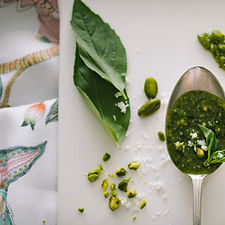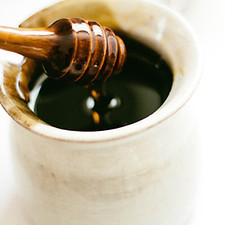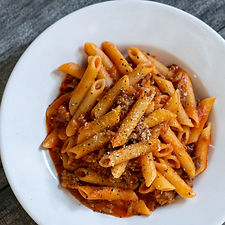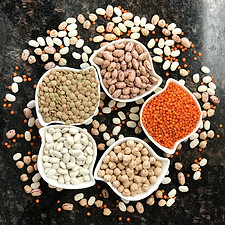
What Are FODMAPs
FODMAPs are a type of carbohydrate (or & " sugar;) found in certain foods. Some people may have
trouble digesting FODMAPS, especially patients with irritable bowel syndrome, a slow-moving gut, or other bowel disorders. This is because the bowel does not easily absorb FODMAPS. Symptoms include: abdominal discomfort, distention, bloating, fullness, nausea, and/or pain after eating foods
containing FODMAPS.
Foods Suitable on a Low-FODMAP Diet

Fruit
banana, blueberry, boysenben-y, canteloupe, cranberry, durian, grape, grapefruit. honeydew melon, kiwifruit, lemon, lime, mandarin, orange, passionfruit, pawpaw, raspberry, rhubarb, rockmelon, star anise, strawberry, tangelo
Note: if fruit is dried, eat in
small quantities

Dairy
Milk:
lactose-free milk, oat milk*, rice milk, soy milk*
*check for additives
Cheeses:
hard cheeses, and brie
and camembert
Yoghurt:
lactose-free varieties
ice-cream substitutes,
gelati, sorbet
butter substitutes,
olive oil

Vegetables
alfalfa, artichoke, bamboo shoots, bean shoots, bok choy, carrot, celery, choko, choy sum, endive, ginger, green beans, lettuce, olives, parsnip, potato, pumpkin, red capsicum (bell pepper), silver beet, spinach, summer squash (yellow), swede, sweet potato, taro, tomato, turnip, yam, zucchini

Sweeteners
sugar (sucrose), glucose, artificial sweeteners
not ending in ·-ol'

Herbs
basil, chili, coriander, ginger, lemongrass, marjoram, mint,
oregano, parsley,

Honey Substitutes
golden syrup*, maple syrup*, molasses, treacle
*small quantities

Cereals
gluten-free bread or cereal products
Bread:
100% spelt bread rice oats polenta
Other:
arrowroot, millet, psyllium, quinoa, sorgum, tapioca
Eliminate Foods Containing FODMAPs

Fruit
apple, mango, nashi, pear, tinned fruit in natural juice, watermelon

Miscellaneous
chicory, dandelion, inulin

Sweeteners
fructose, high fructose corn syrup, large total fructose dose, concentrated fruit sources, large serves of fruit, dried fruit, fruit juice, corn syrup, fruisana

Sweeteners
fructose, high fructose corn syrup, large total fructose dose, concentrated fruit sources, large serves of fruit, dried fruit, fruit juice, corn syrup, fruisana

Dairy
milk from cows, goats or sheep, custard,
ice cream, yoghurt, cheeses
soft unripened cheeses eg. cottage, cream, mascarpone, ricotta

cereals
wheat and rye, in large amounts eg. bread, crackers, cookies, couscous, pasta

Vegetables
asparagus, beetroot. broccoli, brussels sprouts, cabbage, eggplant, fennel, garlic, leek, okra, onion (all), shallots, spring onion

legumes
baked beans, chickpeas, kidney beans, lentils
The table below lists the names of the carbohydrates that are considered FODMAPs.
Fructans and Galactins
-
Fructose
-
Lactose
-
Fructooligosaccharides
-
Galactooligosaccharides
Polyols
-
Sorbitol
-
Mannitol
-
Xylitol
-
Maltitol
Fructose* and Glucose
Fructose is a naturally occurring sugar found in fruit, vegetables, and honey. Fructose intolerance can occur in people with irritable bowel syndrome and other bowel disorders. Fruits and fruit juices with higher levels of fructose may cause gas, bloating, abdominal cramping, and diarrhea.
Glucose is also a naturally occurring sugar. Fruits and juices with more glucose (and less fructose) may be more "intestine-friendly". The tables in the following section list which fruits, juices, and other foods may be better choices for patients with FODMAP intolerance.
High Fructose Corn Syrup (HFCS) *
HFCS is an ingredient in many processed foods. HFCS is made up of almost half glucose and half fructose. HFCS may be easily digested by some patients. Therefore, items with HFCS, such as soft drinks, may be tolerated well if they are limited to 12 oz per day and are taken with a meal.
* In some patients, even a small amount of processed fruit juice or HFCS may cause intestinal discomfort and/or ma/absorption.
Sorbitol
Sorbitol (or sorbose) is a sugar alcohol that is found naturally in fruits and fruit juices. It is used as an artificial sweetener. It can also be found in many "diet foods" or "diabetic" foods (such as diet soft drinks, sugarless gum, sugar-free jelly/jam, and other sugar-free foods). It may also be found in liquid medications. Sorbitol often creates similar symptoms to fructose, especially when fructose and sorbitol are ingested together.
General Guidelines
-
Eliminate products with ingredients that list fructose, crystalline fructose (not HFCS), honey, and sorbitol on the label.
-
Avoid sugar alcohols. These include sorbitol, isomalt, lactitol, maltitol, mannitol, xylitol, erythritol, and lactatol. These are often found in "diet" or "diabetic foods" such as diet drinks, ice cream, candy, processed goods, etc.
-
Limit drinks with HFCS. If used, drink less than the recommended serving size--less than 12 oz of soda (may help to drink with a meal).
-
Check your medications for fructose and sorbitol. They are not always listed on the label, so check with your pharmacist or the manufacturer.
-
Keep in mind that the amount of fructose found in 2 apples (or 2 oz of honey) is the same as the amount of fructose in 1 can of soda (note: apples have other nutritional benefits).
Follow the guidelines below to choose fruits, vegetables, and other foods that are friendlier to your intestines!
Fruits
-
Serving size is ½ cup
-
Limit to 1 to 2 servings per day.
-
Fresh or fresh frozen fruit may be better tolerated than canned fruit.
-
Keep in mind that tolerance may depend on the amount you eat at one time.
-
Limit concentrated sources of fruit--such as dried fruit and fruit juices
-
Avoid eating large amounts of any fruit.
Vegetables:
-
Serving size is ½ cup (most vegetables) or 1 cup of leafy green vegetables
-
Limit to 1 ½ to 3 servings per day.
-
Cooked vegetables may be tolerated best as cooking causes a loss of free sugars.
-
Keep in mind that tolerance may depend on the amount you eat at one time.

The foods listed as "Foods to Avoid" should not be eaten because of their high FODMAP content. These are otherwise healthy foods.
Intestine Friendly
Bananas*, blackberries,
blueberry, grape,
grapefruit, honeydew,
kiwifruit, lemons, limes,
mandarin orange, melons,
oranges, papaya,
passionfruit, pineapples,
raspberries, rhubarb,
strawberries, tanqelos
Foods to Avoid if FODMAP Intolerant
Apples, apple cider, apple
juice, applesauce, apricots,
cherries, dates, grapes,
lychee, mango, peaches,
pears, pear juice, plums,
prunes, watermelon
Questionable Foods/Foods to Limit
Other fruit juices or
drinks, sugar-free
jam/jelly, dried fruit,
canned fruit in heavy
syrup, other fruits
Intestine Friendly
Bamboo shoots, bok choy, carrots, cauliflower*, celery, cucumber*, eggplant*, green beans*, green peppers*, leafy greens, parsnip, pumpkin, spinach, sweet potatoes, white potatoes, other root vegetables
Foods to Avoid if FODMAP Intolerant
Artichokes, asparagus, some beans (baked beans, chickpeas, kidney beans, lentils) beetroot, broccoli, Brussels sprouts, cabbage, cauliflower, fennel, garlic, sugar snap peas, leeks, soy products, okra, onions, peas, shallots
Questionable Foods/Foods to Limit
Avocado, corn, mushrooms, tomatoes, other beans
Intestine Friendly
-
All meats
-
All fats
-
Yogurt and hard cheeses
-
All eggs
-
Aspartame (Equal® and Nutrasweet®)
-
Saccharin (Sweet 'n Low®)
-
Sucrose (table sugar)
-
Glucose
-
Maple syrup
Foods to Avoid if FODMAP Intolerant
-
Rye and rye products (rye bread and crackers), wheat and wheat products
(cous-cous, cream of wheat, wheat crackers, pasta, wheat bran, etc.) -
Honey
-
Flavorings with fructose or sorbitol
-
Desserts (ice cream, candy, cookies, bars, popsicles) sweetened with fructose or sorbitol
-
Cereal or other processed foods with sorbitol or fructose on the label
-
Sherry and port wine
-
Sweeteners such as sorbitol, mannitol, xylitol, maltitol, and isomalt used in sugar-free aum, candies and mints
Questionable Foods/Foods to Limit
-
Limit products with HFCS if symptoms still continue
-
If you experience symptoms with lactose, try limiting milk, cottage cheese, and other lactose- containing foods (see Lactose Intolerance handout)
Other Foods and Food Additives:
* Possible gas-forming foods may need to be avoided
Medications:
Many liquid medications and some personal care items may contain lactose or the sugar alcohols (sorbitol, mannitol, xylitol, maltitol, isomalt). Examples include: liquid pain relievers (including liquid gel caps), cough medicines, and cough drops. If possible, choose a tablet or caplet form instead of liquid medication. If you have eliminated FODMAPs from your diet and are still having symptoms, talk to your pharmacist to see if any of your medications contain lactose or sugar alcohols.
Additional Resources:
-
Visit: www.Ginutrition.virginia.edu
o Go to Nutritional Issues in Practical Gastroenterology and find the August 2007 article on "Clinical Ramifications of Malabsorption of Fructose..."
A Sample Menu Based on the Foods Recommended on a Low FODMAP Diet List.
Include 6-8 glasses of water every day.
Monday
-
Breakfast: Smoothie made with banana, frozen strawberries, flax seeds, and almond milk, green tea.
-
Lunch: Sandwich made with gluten-free bread, leftover roast beef, Swiss cheese, mayonnaise and alfalfa sprouts, gluten-free crackers, snack, cantaloupe, glass of lemonade.
-
Dinner: Baked chicken cooked with the spring-green part of an onion, sunflower seed cooking oil, salt, pepper, and topped with an HCFS sauce to serve, brown rice, steamed green beans with sliced almonds.
Tuesday
-
Breakfast: Oatmeal with blueberries and brown sugar, coffee.
-
Lunch: Leftover baked chicken, salad made with spinach, tomatoes, mandarin oranges, and a raspberry (HCFS free). vinaigrette, gluten-free crackers, snack, sunflower seeds, glass of limeade.
-
Dinner: Pork stir-fry made with cabbage, carrots, water chestnuts, bamboo shoots, and green beans, brown rice, peppermint tea.
Wednesday
-
Breakfast: Smoothie made with banana, frozen blueberries, chia seeds, and almond milk, coffee.
-
Lunch: Salad made with spinach, tomatoes, almond slices, tuna, and a raspberry (HCFS-free) vinaigrette, snack. Lactose-free yogurt with strawberries, a cup of weak black tea.
-
Dinner: Beef stew made with allowed foods, i.e., parsnips (no tomato paste or onions).
Thursday
-
Breakfast: Oatmeal with banana slices, almond milk and brown sugar, coffee.
-
Lunch: Sandwich made with gluten-free bread, turkey (no HFCS), Swiss cheese, alfalfa sprouts, HFCS-free mayonnaise and mustard, snack, cantaloupe, limeade.
-
Dinner: Chicken adobo made with none of the foods to avoid, gluten-free chips, and salsa made with tomatoes, onion, greens, parsley, and limes, cup of peppermint tea.
Friday
-
Breakfast: Smoothie made with banana, frozen strawberries, flax seeds and almond milk, cup of coffee.
-
Lunch: Gluten-free chips with melted cheddar cheese, diced tomatoes, bell peppers and olives, snack, leftover gluten-free chips and salsa, limeade.
-
Dinner: Pan-fried shrimp cooked in sunflower oil, topped with lemon, brown rice, stir-fry vegetables: carrots, cabbage, green beans, and bean sprouts.
Saturday
-
Breakfast: Gluten-free waffles covered with blueberries and maple syrup (made with no HFCS), cup of. coffee.
-
Lunch: Salad made with lettuce, bell pepper, tomato, alfalfa sprouts and topped with HFCS-free dressing, snack, lactose-free yogurt with strawberries, cup of weak black tea.
-
Dinner: Baked ham slices topped with pineapple chunks, potatoes baked in sunflower seed oil, salt, and rosemary leaves, and baked green beans topped with almond slices.
Sunday
-
Breakfast: Omelet with cheddar cheese, bell peppers, spinach, olives, and tomatoes, gluten-free toast with lactose-free spread, coffee.
-
Lunch: A sandwich made with gluten-free bread and turkey (no HFCS), Swiss cheese, alfalfa sprouts, HFCS-free mayonnaise, and mustard, corn chips, a snack, sunflower, and a Glass of lemonade.
-
Dinner: Roast beef, potatoes baked with salt and rosemary, salad made with lettuce and tomatoes, and no HFCS balsamic vinegar dressing, a glass of weak peppermint tea.
